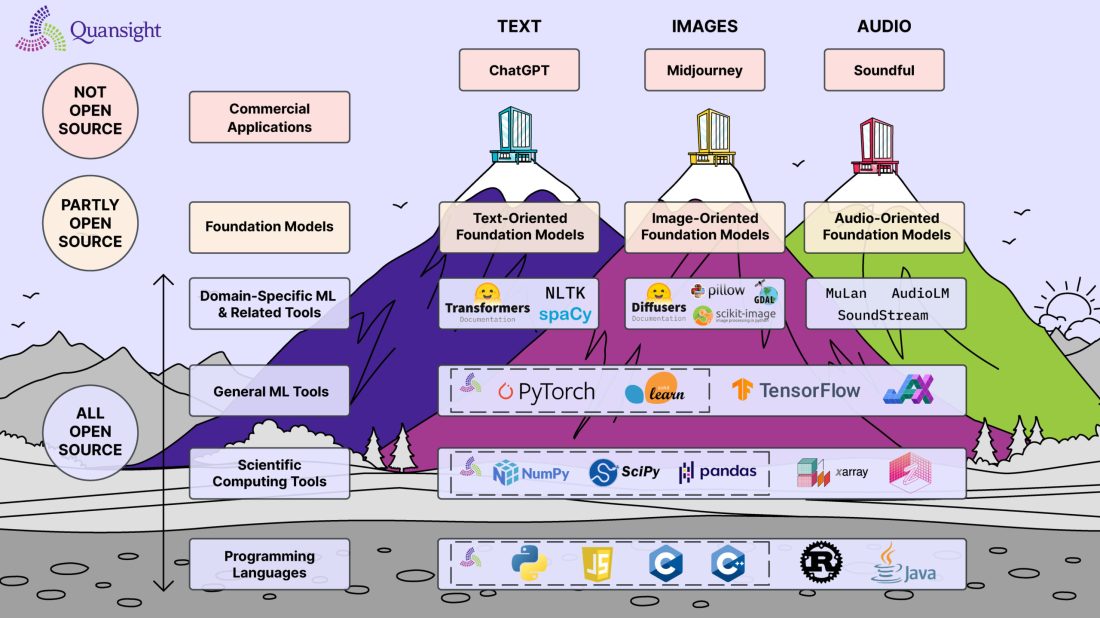Last year, the successes of generative AI in image, audio, and language production revolutionized the way people perceive technology and its capabilities. This came into broad focus as OpenAI’s ChatGPT hit the mainstream. From Google’s internal “code red” as the company analyzed a potential threat to how people search the internet to other large tech companies scrambling to release AI models of their own—the response was unprecedented and for many, unexpected.
Since OpenAI’s breakthrough, there’s been a maelstrom of innovation with hundreds of generative AI products, tools, and projects being created to offer AI-supported services for everything from writing to image generation, to code creation to video production and beyond.
And while the famous names like ChatGPT, Claude, Bard, and WatsonX are those that most people know, many people don’t recognize that these products and tools would not be possible without a vast array of open source tools and open source communities upon which generative AI is built.
In this post, we have two goals: the first is to emphasize the immense open source foundations of generative AI. The second is to highlight Quansight’s depth of expertise both in AI/ML tools and generative AI technologies in particular, and in the open source scientific computing space in general. To do this, we created the diagram below.
This diagram illustrates the myriad of open source technologies underlying modern generative AI. As we explore the various levels in the diagram, we want to make clear that we’re not suggesting the tools on each level are directly dependent on all of the tools at lower levels. Instead, we are calling out how the tools, models, and products at each level are dependent on some projects in the categories of each layer beneath it, even if they’re not dependent on the specific projects we mention.
In particular, since Quansight is a scientific Python consultancy, we’ve focused heavily on Python tools and libraries often used together for AI/ML applications, and we’ve marked in the diagram the projects that we maintain or have significant expertise with. But, the ecosystem of open source underlying generative AI is much broader than we can possibly show in one diagram.

Starting from the bottom row of the diagram and moving upward:
We proudly stand at the forefront of expertise across the Python Generative AI stack. Our involvement extends to key projects, such as maintaining NumPy and SciPy, being PyTorch maintainers, and having expertise with foundation models. We encompass a broad spectrum, from using and enhancing models to managing data, building MLOps pipelines, and optimizing infrastructure.
We are also the creators of Nebari, a versatile tool that configures and manages essential elements like cloud instances, containers, Kubernetes, and UI platforms, ensuring a streamlined experience. In particular, Nebari can be used to set up your own generative AI system, allowing you to customize it how you need and not send your data to third party services.
Key elements of our expertise at each level of the diagram are:
Here at Quansight, we believe open source is not just the foundation of generative AI but is the very bedrock of essentially all modern software and technology—underpinning everything from the internet to smartphones and beyond. We believe this so strongly, in fact, that we wrote a book—Open Source For Dummies—on open source and its importance in the modern world.
However, achieving sustainability in open source is a challenge that necessitates business model innovation. The free and open nature of open source software is a key element of its success, but the development and maintenance of open source is not free: maintainers have to make a living, and if they’re not paid to do that maintenance work it can lead very quickly to overload and burnout, especially for projects at the foundations that become widely popular without clear sponsorship
Quansight and Quansight Labs are at the forefront of addressing these challenges and driving sustainability within the open source ecosystem. In fact, open source sustainability is the key reason why we created Quansight Labs: linking our paid consulting work to support for maintainers of key projects on this generative AI mountain. We’re in the company of many teams working to build sustainable open source models, including our sister company OpenTeams and others like NumFOCUS, Tidelift, Anaconda, the Apache Foundation, and the Linux Foundation. Working toward open source sustainability is a critical element of who we are.
If you’re looking for expertise on any level of the OSS mountain range that builds up to generative AI on the peaks, reach out and start leveraging the power of open source generative AI in your business.
Or, if you’re interested in talking further about open source sustainability, we want to hear from you, too! We will point you to additional information and resources to help you connect your company sustainably with open source communities.